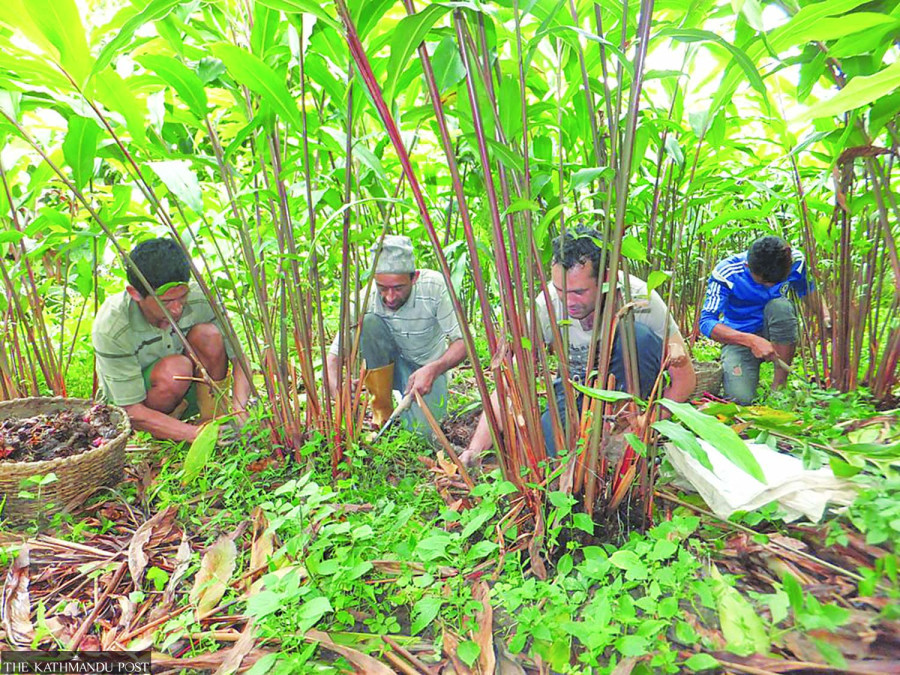Money
Large cardamom prices reach near-record levels
The spice, which is among the most expensive in the world, was treated at Rs2,150 per kg in the domestic market this week.
Post Report
Large cardamom prices have reached near-record levels, with one of the world's most expensive spices trading at Rs2,150 per kg in the domestic market this week.
It was Rs1,875 per kg in mid-December.
The large cardamom grown in Nepal, known as Alaichi, is one of Nepal's largest export crops.
Large cardamom is harvested from mid-August to mid-November.
At the start of the season this year, the spice was being traded at Rs1,250 per kg, according to the Federation of Large Cardamom Entrepreneurs Association of Nepal. Birtamod in Jhapa is the main trading hub of the valuable spice.
Subash Bhattarai, vice president of the Large Cardamom Entrepreneurs Association of Nepal, said that the price may breach the 2014 level this year.
In 2014, large cardamom hit an all-time high of Rs2,500 per kg.
“There is a huge overseas demand for the spice as output dropped sharply in Nepal, the top producer, including in India,” said Bhattarai.
Nepal is the largest producer of large cardamom, accounting for 68 percent of the global production, followed by India and Bhutan.
The spice is grown in Sikkim, Darjeeling and Bhutan. Large cardamom was introduced in Ilam from Sikkim in 1865.
Ilam, Panchthar, Taplejung, Sankhuwasabha, Tehrathum, Bhojpur and Dhankuta districts are the major large cardamom-producing districts in Nepal.
The large cardamom output dropped by 60 percent year-on-year due to drought and pest problems in the key producing areas, said Bhattarai.
“The old stock got cleared last year. This year, the production dropped sharply, and as a result demand for the commodity has increased,” said Bhattarai.
India is the biggest buyer of Nepal’s large cardamom, absorbing 99 percent of its exports. The spice is re-exported to Pakistan and the Middle East where it fetches high prices because of local preference for the Nepali product.
Pakistan is the largest importer of large cardamom, purchasing roughly 60 percent of India’s large cardamom exports. Large cardamom pods are used by the local Muslim community in biryani, a popular Pakistani dish, as a symbol of prosperity and wealth.
According to Bhattarai, large cardamom has three types depending on quality.
The ‘jumbo jet’ is a big one, the standard one and the third normal. There is a difference of Rs1,000 between the qualities.
In 2014, large cardamom hit an all-time high of Rs2,500 per kg. Since then, prices have been going steadily downhill, sinking to a low of Rs700 per kg in mid-July in 2022.
Large cardamom is a high-value cash crop and a major source of income for farmers in the mountains and hills of eastern Nepal.
According to the Department of Customs, the country exported 2,374 tonnes of large cardamom worth Rs3.09 billion in the first five months of the current fiscal year ended in mid-December. Exports were 3,402 tonnes worth Rs2.72 billion in the same period last fiscal year.
Nepal exported 9,990 tonnes of large cardamom worth Rs8.27 billion in the last fiscal year compared to 5,367 tonnes worth Rs4.81 billion in 2021-22.
According to the Agriculture Ministry statistics, Nepal produced over 10,000 tonnes of large cardamom in the last fiscal year. In 2019-20, output was 9,545 tonnes, which dropped to 8,289 tonnes in 2020-21. In 2021-22, production rose slightly to 8,714 tonnes.
Farmers are expanding the large cardamom acreage beyond the eastern hill districts. The spice is being grown in Dadeldhura and Lamjung too.
Large cardamom is grown on 18,000 hectares in Nepal. Domestic consumption of large cardamom is minimal.
Nepali traders were also making efforts to export large cardamom to Bangladesh directly through the Kakarbhitta-Panitanki-Phulbari route as demand has increased there, traders said.
The 44-km route provides the shortest access to the Bangladeshi border point of Banglabandha for Nepal's trade with and through Bangladesh.
Nepali large cardamom or black cardamom has a distinct flavour profile due to a specific method of postharvest drying in bhattis (ovens), which explains the roasted smell and taste.
The smoky flavour would overwhelm a sweet cake or pudding, but in a spice rub for roasted meat or a full-flavoured stew, it imparts a smouldering depth no other spice can, according to experts.
In February 2021, the process of identifying and registering five species of large cardamom indigenous to Nepal formally began paving the way for claiming the rights of ownership and patenting them internationally.




 13.12°C Kathmandu
13.12°C Kathmandu














